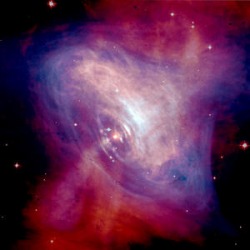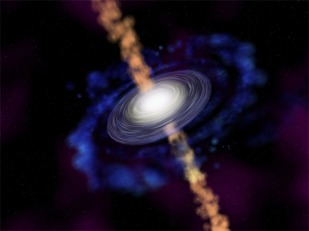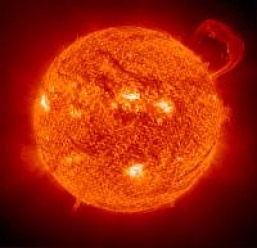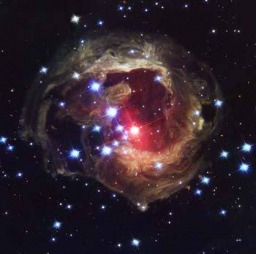The Cycle:
- A star forms out of a nebula
- It becomes a Protostar
- The star tries to maintain equilibrium
- The Main Sequence takes place
- The star either becomes a Red Giant or a Red Super Giant
- The star collapses and explodes
- A million years later, the star *cools down
- A Red Giant collapses until it becomes a Planetary Nebula
- A Red Super Giant creates a Super Nova when it explodes
- *If the star was small, it becomes a White Dwarf. (It becomes a Black Dwarf after more years)
1. Nebula Phase
A Nebulais an interstellar cloud of dust and gas it is made up of 97% hydrogen and 3% helium. When some of the dust and gas gathers together and form a clump, a protostar is born.
2. Protostar Phase
A Protostar is simply a "New Star". This is when the star struggles to achieve Equilibrium. Equilibrium is the condition of a system in which competing influences are balanced, and in this case, the two competing influences are Gravity and Gas Pressure. When the protostar reaches the balance, it starts the "Main Sequence" Phase.
3. The Main Sequence
The Main Sequence takes place during most of the star's life. The star is now an actual "Star". It (the star) spends most of it's life fusing hydrogen into helium in it's core. When the star runs out of hydrogen, it starts fusing helium into carbon. This continues for 90% of the star's life.
4. The Collapsing Phase
When the star runs out of a specific type of gas to fuse, nuclear reactions --that keep the star from breaking down-- stop and the star collapses on itself. The star keeps on falling apart until it swells. It either becomes a Red Giant or a Red Super Giant.
5. The Death Phase
Small and Large stars die differently. Their deaths do not have THAT big of a difference, but you can tell if it is a small or large star that died.
Small stars, as it said in the collapsing phase, starts to fall apart on itself. It keeps on collapsing and eventually it explodes. A small star explodes and turns into a planetary nebula. Sometimes a part of the star survives the explosion, and that part is still very hot. In a million years, that part cools off (it still is fairly warm) and becomes a White Dwarf Star. A million more years after that, the star cool off more (it's now a floating rock) , thus, turning into a Black Dwarf Star.
Large stars die the same way, but somewhat different. It (a large star) also collapses and explodes. This is how the explosion happens:
First, the star swells. It swells until it is as big as the orbit of Earth or Mars. As it falls on itself, carbon gets crushed into neon and magnesium, while oxygen crashes into silicon and sulfur. Silicon and sulfur then hit the iron core. The core starts to break down by size at about 5,000 to 12,000 miles in less than a second. This "Surprise Crash" makes protons and electrons combine and form neutrons. That small crush lets in a small charge of energy that enters the core's surface triggering the Supernova.
Small stars, as it said in the collapsing phase, starts to fall apart on itself. It keeps on collapsing and eventually it explodes. A small star explodes and turns into a planetary nebula. Sometimes a part of the star survives the explosion, and that part is still very hot. In a million years, that part cools off (it still is fairly warm) and becomes a White Dwarf Star. A million more years after that, the star cool off more (it's now a floating rock) , thus, turning into a Black Dwarf Star.
Large stars die the same way, but somewhat different. It (a large star) also collapses and explodes. This is how the explosion happens:
First, the star swells. It swells until it is as big as the orbit of Earth or Mars. As it falls on itself, carbon gets crushed into neon and magnesium, while oxygen crashes into silicon and sulfur. Silicon and sulfur then hit the iron core. The core starts to break down by size at about 5,000 to 12,000 miles in less than a second. This "Surprise Crash" makes protons and electrons combine and form neutrons. That small crush lets in a small charge of energy that enters the core's surface triggering the Supernova.
This video explains the process by animation.
This video is made by banabel. He/she, as it said in the video's description, made this presentation for school.
Highlighted Words:
- Nebula (noun, plural form Nebulae) - is a cloud of interstellar dust and gas
- Protostar (noun) - an early stage in the formation of a star
- Equilibrium (noun, plural forms Equilibriums, Equilibria) - a state of balance due to the equal action of opposing forces
- Supernova (noun, plural forms Supernovas, Supernovae) - the explosion of a star caused by gravitational collapse
- Red Giant / Red Super Giant (noun) - a star in an intermediate stage of evolution






